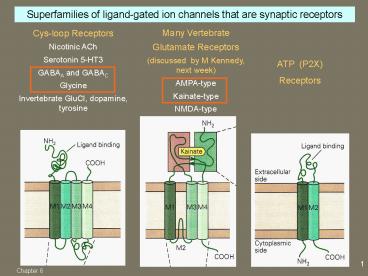Ion Selection: Cationic Channels - PowerPoint PPT Presentation
1 / 26
Title:
Ion Selection: Cationic Channels
Description:
(discussed by M Kennedy, next week) AMPA-type. Kainate-type. NMDA-type. ATP (P2X) Receptors. 1. Chapter 6. GABA and Glycine receptors ... – PowerPoint PPT presentation
Number of Views:62
Avg rating:3.0/5.0
Title: Ion Selection: Cationic Channels
1
Superfamilies of ligand-gated ion channels that
are synaptic receptors
Many Vertebrate Glutamate Receptors (discussed
by M Kennedy, next week) AMPA-type Kainate-type
NMDA-type
Cys-loop Receptors Nicotinic ACh Serotonin 5-HT3
GABAA and GABAC Glycine Invertebrate GluCl,
dopamine, tyrosine
ATP (P2X) Receptors
1
Chapter 6
2
GABA and Glycine receptors
- Both are cysteine-loop pentameric receptors.
- GABA (?-amino-butyric acid) is the principle
inhibitory transmitter in the brain. - GABA receptors contain three or four different
kinds of subunits. - 6 ? subunits, 3 ? subunits, 3 ? subunits, ?, ?,
?, and ? subunits. - In general, ?, ?, and ?? subunits are all
required for receptor function. - Only a limited number of subunit combinations
exist.
- Glycine (Gly) is the predominant inhibitory
transmitter in the spinal cord. - Glycine receptors contain two different types of
subunits. - 4 ? subunits, and 1 ? subunit
- Stoichiometry is fixed at 3?2?
3
Take home lesson is that GABA receptors are more
variable than glycine receptors in subunit
composition and therefore in kinetic behavior.
4
GABA Receptor Subunit Composition
GABA receptors usually contain at least one each
of ?, ?, and ? subunits.
A typical subunit composition
Katzung (Ed.) Basic Clinical Pharmacology,
Lange (2004)
5
Before we examine how selectivity for Cl- is
achieved, recall the model for gating of the
cysteine-loop receptors
Polar Ser or Thr (Selectivity Filter)
Hydrophobic Leu (Gate)
Modified from Zigmond et al. (Eds.) Fundamental
Neuroscience, Sinauer (1999)
6
Ion Selection Cationic Channels
(for contrast)
Modified from Keramidas et al., Prog. Biophys.
Mol. Biol. 86 161 (2004)
7
Ion Selection Chloride Channels
Modified from Keramidas et al., Prog. Biophys.
Mol. Biol. 86 161 (2004)
8
How does binding of GABA promote opening of the
pore?
Polar Ser or Thr (Selectivity Filter)
Hydrophobic Leu (Gate)
Modified from Zigmond et al. (Eds.) Fundamental
Neuroscience, Sinauer (1999)
9
Coupling between ligand binding and gating
requires interactions between the Cys Loop and
the TM2-TM3 Linker
Kash et al., Nature 421 272 (2003)
10
Gating of GABA Channels InteractionBetween the
Cys-Loop and the TM2-TM3 Linker
K279 in linker D149 in loop
Kash et al., Nature 421 272 (2003)
11
Pharmacology of Inhibitory Receptors
GABA agonists
Benzodiazipines Valium (diazepam) Ambien
(zolpidem, short acting)
Barbiturates Phenobarbital Secobarbital
(Seconal)
12
Benzodiazepines and Barbiturates EnhanceGABAA
Currents Through Different Mechanisms
Probability of Opening
Open Time
Twyman et al (1989) Ann. Neurol. 25 213-220
(1989)
13
GABA and Glycine Antagonists
GABA antagonists Bicuculline
picrotoxin
Glycine antagonist Strychnine
14
Receptors are clustered at postsynaptic sites by
specialized molecular scaffolds
15
Clustering of Receptors at the Postsynaptic
Membrane
The Neuromuscular Junction
From Banks, Froehner et al. J. Neurocytol. 32,
709 (2003)
16
Clustering of Receptors at the Postsynaptic
Membrane
Glycine and GABA receptors (inhibitory junctions)
From Kneussel and Loebrich, Biol. Cell 99, 297
(2007)
17
I will return to the scaffold for glutamate
receptors (called the postsynaptic density) in
later lectures.
18
Superfamilies of ligand-gated ion channels that
are synaptic receptors
Many Vertebrate Glutamate Receptors (discussed
by M Kennedy, next week) AMPA-type Kainate-type
NMDA-type
Cys-loop Receptors Nicotinic ACh Serotonin 5-HT3
GABAA and GABAC Glycine Invertebrate GluCl,
dopamine, tyrosine
ATP (P2X) Receptors
18
19
Topology of Glutamate Receptors
Kandel, Schwartz Jessel, Principles of Neural
Science 4th Ed. (2000)
20
Ionotropic Glutamate Receptor Subunitsare
Tetramers formed by 4 homologous subunits
3 Families NMDA AMPA
Kainate NR1 GluR1-4 (A-B) GluR5-7
NR2A-D (Most are KA1-2 composed
of NR3A-B GluR1/2 or GluR2/3)
obligatory
21
Ion Selectivity of Glutamate Receptor Channels
AMPA and Kainate Receptors With GluR2
subunit permeable only to K and Na
Without GluR2 subunit Ca2-permeable
(and K, Na) NMDA Receptors Permeable
to K, Na, Ca2 Relatively high
conductance
22
RNA Editing Determines Ca2-Permeability of AMPA
Receptors
Right Modified from Zigmond et al. (Eds.)
Fundamental Neuroscience, Sinauer (1999)
23
RNA Editing DeterminesCa2-Permeability of AMPA
Receptors
Kandel, Schwartz Jessel, Principles of Neural
Science 4th Ed. (2000)
24
Isolating AMPA-R and NMDA-R CurrentsWith
Selective Blockers
Nestler, Hyman, Malenka, Molecular
Neuropharmacology McGraw-Hill (2001)
25
Isolating AMPA-R and NMDA-R CurrentsWith
Selective Blockers
D-APV selectively blocks NMDA receptors
CNQX selectively blocks AMPA receptors
Nestler, Hyman, Malenka, Molecular
Neuropharmacology McGraw-Hill (2001)
26
In this lecture, Ive described the Ligand-gated
GABA and glycine receptors, which are inhibitory.
Ive also introduced the excitatory AMPA-type
glutamate receptors.
In the next lectures, Ill discuss synaptic
plasticity in the CNS, and describe NMDA-type
glutamate receptors in detail. Ill also discuss
trafficking and scaffolding of AMPA and NMDA
receptors.































